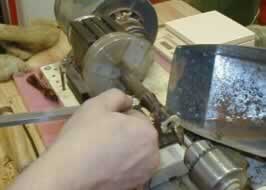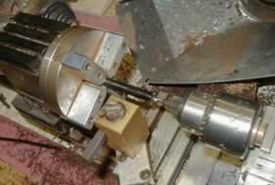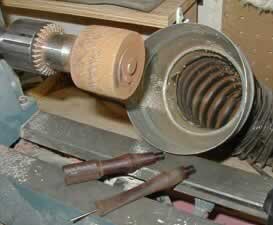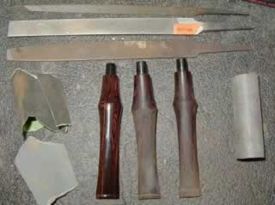Stem Work
From Creating, Briar, by Trever Talbert, from his website, and used by permission.
Stem Work
I let the freshly-drilled stummel sit for awhile before turning a tenon to fit. This period is normally at least a week and usually more, depending on the initial age of the briar. During this time, the mortise will change size slightly due to exposure to existing humidity and temperature conditions. I let this happen indoors, so that the environment will best match what the pipe is likely to end up in.
I mount the stem on the lathe to turn the tenon. I use a self-centering chuck for easy setup, and I can quickly get either rod stock or a molded stem turning true. Once it's mounted, I do one of two things - either turn a tenon from the material of the stem itself, or drill and level the end so that an internal tenon of Delrin can be installed. I also do any required stem shaping now.
Here I am using a traditional wood-turning blade to cut and shape a vulcanite rod as it spins. You can also see the drill bit used to make the hole for the Delrin tenon.
If I'm turning a traditional tenon, I also do that while the stem is mounted, using the metal lathe's cutting tool. More commonly however, I prefer the performance gained by using an insertable Delrin tenon instead. Delrin is tougher and more resilient than either vulcanite or acrylic, and it has better surface lubricity which allows for a smoother, squeak-free fit (my biggest dislike in acrylic stems is the nails-on-chalkboard chirping sound of inserting the tenon). I simply drill and cut lengths of Delrin for each tenon and permanently fix them into the drilled stem rod.
Here you see a Delrin rod mounted in the lathe, ready to be drilled and sliced off to become a tenon fitting.
The next step is to shape the stem. It must be transformed from a thick rod into something approaching its final shape. Below you can see a pair of stems in the process of being shaped. I use sanding drums and some customized open-center sanding wheels for this process. The stems can be shaped fairly close to their final appearance, but the most exacting work must be done with files by hand.
Here are two stems being prepared for the 1999 Yule pipes. Both have Delrin tenons already inserted. The upper rod has yet to be touched, while the lower has been shaped close to its final form. The small drill bit you see protruding from the lower stem's bit is a handy guide that I use to avoid shaping too close to the airhole.
The final step in the process is the longest and most painstaking. The rough-shaped stems must be hand-filed to their precise final design, then sanded by hand until they are smooth enough to be polished. Getting the shape of the bit that I prefer it is a protracted process, and the whole experience is a trial in nitpickiness.
Here you see the tools used in finishing a handcut stem - files and sandpaper. You can also see a full transition in stem creation, starting with the rod section on the far right. Next over is a rough-shaped stem, then a stem which has been fully filed and shaped but still needs sanding and polishing. On the left is the finished, bent, stem.



